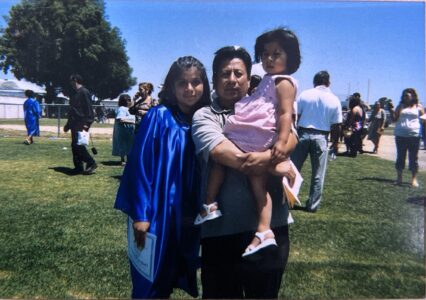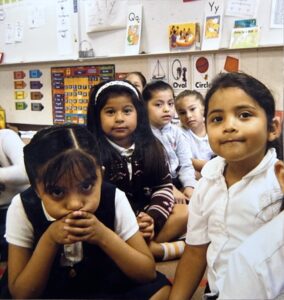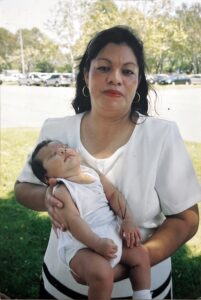 I will never forget the eventful morning when the red and blue lights were flashing through my bedroom window in my childhood home in Santa Ana, and my brother frantically woke me up. Gaining consciousness, I realized the police were on my family’s front yard arresting a “chola” who had been on the run.
I will never forget the eventful morning when the red and blue lights were flashing through my bedroom window in my childhood home in Santa Ana, and my brother frantically woke me up. Gaining consciousness, I realized the police were on my family’s front yard arresting a “chola” who had been on the run.
She looked around my older sister’s age, 17, and her sad eyes as she was being pulled away still come to mind when I think about the incident. Acting like it was another typical morning, my neighbors continued on with their routines and my mother with her coffee sips.
I looked at my sister, and I thought, this could have been her. I’d seen this happen so many times in my neighborhood, but this time it felt too close to home. I knew I didn’t want that to be me.
Looking back, I couldn’t help feeling dismal and thinking, I don’t want someone to just look at me and think, “There goes another chola,” and walk away without considering that I am a person and there is a story and feelings within. People usually don’t just act out without there being a reason.
From my “Rebelde” obsession to blasting my favorite Selena Quintanilla song “No Me Queda Mas,” I was always proud to express my culture, even as a kid.
By the time I was at the age of 8, I had already familiarized myself with my neighborhood in Santa Ana. From memorizing the routes to 4th Street, taking trips to my mom’s favorite panaderia, and walking by all the small Mexican corner shops nearby, I got to interact with numerous Mexican Americans in my neighborhood. As I watched single, working mothers rush their kids to school and exhausted elders commuting by bus to their jobs, it made me realize very early on in my life just how hard-working Latinos are. Although I was always a proud Latina, it wasn’t until I got older and after facing different kinds of discrimination, that I started to think of myself as a Chicana.

When I moved to Tustin at age 11, I became more aware that I was seen differently because of the color of my skin and my indigenous features. That was in 2012. Things only got more intense leading up to the 2016 presidential election. The community in Tustin was still very Hispanic, but there wasn’t as much of a chola culture and activity compared to my neighborhood in Santa Ana.
The chola look today has inspirations from the ’90s and early 2000s and began to get more recognition after movies like “Mi Vida Loca” (1994) and “Mi Familia” (1995) became more mainstream. The classic makeup look consists of thin eyebrows, overlined lip liner/lip gloss combo and accessories like hoop earrings. Bandanas, baggy Dickies jeans or khakis and flannels have become a signature look for cholas and continue to be trendy.
Artist William Camargo often associated himself with both Chicanos and cholos and has taken a notice of the popularized term., “Cholas are seen as an aesthetic but they don’t actually have a lifestyle as a real one,” he says. Cholos are frequently seen the same as Chicanos, and many Chicanas have been criminalized because of the reputation the term chola has. There are higher rates of police brutality and injustices in Mexican communities. According to CNN.com studies have shown that over the last 6 years, more than 2,600 Latinos were killed due to police brutality.
Over time the chola style has been culturally appropriated by the media and artists. For example, Gwen Stefani, who isn’t Mexican, has appropriated and profited off chola culture with the music video to her hit “Luxurious.” While she profits, actual Chicanas receive backlash as their look is seen as ‘ghetto.’ I recall going into high end makeup stores with my older sisters, wearing overlined lipstick, butterfly clips and hoop earrings. Oftentimes we were followed around the store by the security. We felt criminalized in a makeup store when all we wanted to do was shop. By the time I moved to Tustin, I already had trouble making friends in elementary school, and experienced being judged for the color of my brown skin and was often excluded. I remember questioning if it had something to do with my personality. In middle school, I remember a time in my math class where one boy asked why I had such a big nose. I was shocked because he himself was a Mexican boy with brown skin and yet he made me feel different because of my features. I would often come home crying.
My mother would always say “no llores” and would comfort me by sharing her experiences coming from Mexico to America. My mother was self-employed, and she raised my siblings and me in an environment where you have to work hard to get what you want. She taught us to be proud to be Mexican American and began my education on the injustices that Chicanos had faced.
I was surrounded by kids who had privileges that I didn’t have at the time. My mother didn’t drive, and us riding the bus everywhere put in perspective for me how hardworking she was. There were times where we’d take the bus to richer neighborhoods and pass around her housekeeping business cards. When she had a goal, she would work hard to attain it. Even with the language barrier and the countless racist encounters she had, she was proud to be a Mexican woman. My mother’s pride and dedication inspired me to take action and speak out.
During high school, I was aware of the racist remarks and “jokes” that were made toward Mexicans. Many non-Hispanic kids were disrespectful to the culture of Mexicans, and although students would speak up on it, administrators weren’t helpful. After encounters and many experiences in my world that were so purposefully frustrating and agitating against me and my community, I began to be more curious about ways my voice and other Mexican students’ voices could be heard.
Joining my community in protests and educating myself on topics that are important to me were ways that I began to honor my voice. This is the time when I started to wonder about the term Chicana and how it applied to me.
Professor Vanessa Ovalle Perez at Cal State San Bernardino specializes in Chicanx and Latinx literature. “If you are identifying as Chicana, your ethnicity or heritage isn’t just Mexican American, but you’re showing you are down with the cause of the movement,” she says.

Learning about the meaning and history behind the term Chicanx can change people’s minds about how to identify themselves. For me, it wasn’t until high school, after gaining more knowledge on the Chicano Movement and having discussions with close friends about Chicano history and our experiences, that my curiosity was enhanced towards the term. With this education and proud identification as a Chicana, the judgmental stares from others no longer bothered me and I was able to join activists in more protests in our communities. I felt supported and could be myself, even in expressing my voice and standing up for what I believe in, with more confidence.
Chicanos have proudly come a long way since “El Movimiento,” which took place in the late 1960s. At the time, the term Chicano was even originally used as a racial slur for Mexican Americans in the United States.
Soon, Mexican Americans reclaimed and identified with the term Chicano. This happened once Mexican Americans started to rethink their place in the U.S. and all that was taking place around and involving them. Mexican neighborhoods began to have gatherings and discussions about the injustices and discrimination they were facing in their cities or by the hands of the U.S. This led to advocating for more rights in their communities.
Chicanos protested against educational segregation that many children of color encountered, and fought for restoration of land, rights for farm workers, and education reforms in their communities.
Marches and national consumer boycotts were arranged as Mexican farm workers defended their rights for higher wages and improved working conditions. In 1965, the Delano Grape Strike was organized by the Agricultural Workers Organizing Committee. They demanded a raise in their hourly wages, from $1.25 to $1.40. The boycott lasted four years and ended in 1970. It brought the issue of injustice against Mexican Americans to the nation’s attention and led to successful changes in the pay raise, health-care benefits, and safety protections for farm workers. Still to this day the hustle for Mexican Americans has never stopped.
Chicanas have always worked hard to make important changes and contributions to our communities. Chicana groups, like “Chicanos por la Causa” and “Chicana Latina Foundation,” are surging and are establishing more resources for low-income neighborhoods. They provide information on where to get free meals and help Mexican students with educational support, such as granting scholarships.
The unity and pride that Mexican Americans have created and shown in neighborhoods and local communities have made such an impact on my life growing up in Orange County. I recall going to community fairs, chatting with and shopping from small business owners and street vendors, and feeling content just to be there surrounded by the culture and pride.
Chicana activist Yesenia Nava says, “To be Chicana you have to want to stand up for the cause with pride for those who can’t.”
Like the chola who got arrested on my front lawn, there are stories behind these lifestyles and people that are seen as aesthetics through the media. I continue to embrace my culture and the people, from dancing my favorite Cumbias with my mother to advocating in my neighborhood. Learning about Chicano culture and embracing my Mexican American self has made me more proud to call myself a Chicana. I take pride in being a Chicana and the hustle throughout my upbringing only elevated that.


